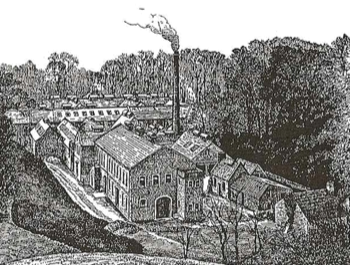A dozen great piles of "water leaf" had come up from the vat room to the hand presses, and here the paper, from which tons of crystal water had already been expressed below, under new and tremendous pressure yielded still more. Indeed, with half a dozen men bearing on the levers of the presses, the "water leaf," that had appeared so dry, beaded and glittered and then exuded further rivulets of moisture. For the last turn of the screw a great beam was thrust into the press and as many men as could get purchase upon it lent their united strength. Ernest Trood, passing through the pressing room, gave a hand, and a stack of newly made paper was subjected to such strain that one had thought it must disintegrate beneath it.
Reference: The Story of Handmade Paper (1924)

Wookey Hole Paper Mill, Somerset
Here, under this tremendous impost, the grain mark, or pattern imparted to each sheet by the felts at the first pressing in the vat room, was removed. For the drying lofts the paper was next destined ...
The drying lofts were enormous airy chambers that ascended to an unceiled roof. Through the twilight gloom of these apartments, the sheets of paper, large and small, glimmered, hanging aloft in multi-coloured reams like fairy washing; pink and blue, yellow and snow-white. The paper seemed to make dim rainbows aloft, where it ascended tier on tier in many thousands of separate pieces. Every sheet was suspended over ropes, strung across transverse beams on light scaffolding, that filled the lofts and ascended into the dark dome of the roof. Above them spun drying fans, to expel the exhausted air and suck away the moisture exuding from the masses of paper; while on the floors beneath there wound and twisted an elaborate system of hot-air pipes, which raised the temperature at will.
Drying is a process that demands watchfulness and judgment, for wet paper suspended here on the tackle does not respond in all its parts simultaneously. From the deckle edge it dries inward and the last spot to dry is the centre of each sheet. The dry workers, with a hand-tool like a T square, hang their sheets over the russet, cow-hair ropes; then when the rope is loaded, pull it aloft; but the art of drying lies in the regulation of heat and air. The heat is great, yet regular; every operation is ordered for cleanliness and purity, so that not a speck of dust may fall to mar a sheet. Here came Matthew Trenchard upon a question of temperature. The talk concerned technical details of ventilation and did not take long, since Trood and his master seldom differed ...
The flat room was another chamber for paper drying. Hither came the great sheets of "double elephant" and "imperial" - precious and wonderful papers for the artist and draughtsman, that could not be hung over a rope or creased. They rested upon beds of webbing, which were lifted one above the other and offered free access to the warm air that plied through them. Here dried noble sheets of a quality that rejoiced the painter who touched their surface, and felt their solid texture. Nicholas Pinhey, spotless and trim, with shining spectacles and a white apron, appeared ... He was carrying a "cross," the little tool used to hang the paper on the lines, and he tapped his points against the wall of the flat room ...